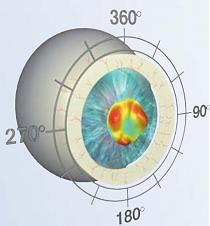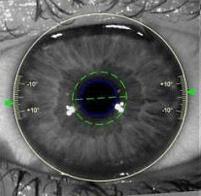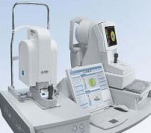Wavefront
Wavefront-analysis enables measuring eye's optical refraction errors essentially more accurately. The accuracy of measuring these errors is by far more accurate than the old technologies for determining near-sightedness, far-sightedness and astigmatism. Wavefront-analyzer measures light deviation when it goes through the eye and is reflected back. Of light it can be thought as a line of moving, straight wave, which is crosswise with light beam's direction. When moving through eye's optically non-perfect places, these waves arch and as a result an eye-optics wavefront-map comes to the analyzer, which showed detailed individual deviations. Though conventional laser surgery has helped millions to get rid of glasses, wavefront-technology brings out every eye's optic uniqueness considering even more to optimize laser beam's settings.
Human's optical system is capable of seeing eyesight test table letters, which are 2 times smaller than those which are considered to be seen with the standard of a healthy eye. Most people can not see more than the so-called standard because of the little deformations of eye optics. Wavefront-technology enables to measure these little deformations and after that plan maximally vision-correcting laser operation. First wavefront-guided treatment was performed in 1999 and in 2002 this method gained FDA's approval. Technology's wider distribution has been hindered by equipment's high price and increasing standards for laser systems, because using wavefront-analysis only gives good results when the laser beam gets exactly to the right spot on the cornea. An important presumption for preciseness in addition to laser's fast tracking system is digital eye axis and pupil position registering.
ReFocus is the only practice in Estonia, which uses wavefront-technology and digital eye axes registration.
Visual Errors
To simplify, visual errors or "aberrations" can be divided into two categories: second-order and higher-order aberrations.
Conventional forms of optical correction have been limited to measuring the best spherical and cylindrical visual errors (second-order aberrations), which result in myopia (shortsightedness) or hyperopia (farsightedness) and regular astigmatism (blurriness), and prescribing shperocylindrical lenses in the form of spectacles, contact lenses, and conventional refractive surgery to correct them.
Correcting second-order aberrations has the highest impact on acuity, which is the eye's ability to distinguish object details and shape. Still approximately 20% of the visual disturbances are higher-order aberrations and if to reduce these, the seeing of contrasts and details of the object would get even better. If to metaphorically compare the cornea with a mountain, then the usual laser surgery removes the more noticeable cavities and unevennesses. Wavefront-guided laser surgery gathers the larger rocks, but the smallest rocks are still left to wait for future technologies.
By using wavefront-technology during an eye laser surgery, the chance of getting a better vision quality rises even higher. Especially important is using this technology on people, who are having larger extent of higher-rate vision disturbances.
Topography- and Wavefront-Guided Treatment
Wavefront-technology measures the whole eye optics. Corneal topography is eye analysis, during which the foremost transparent layer's shape and its unevennesses are mapped. In topography-guided laser surgery cornea map's data is used for navigating the laser beam. As cornea is optically the most important part of the eye, this method gives also relatively good results. Use of topography-guided method is indicated on an eye, which cornea is very uneven or operated earlier. Wavefront-guided laser surgery corrects cornea's surface taking into account whole eye's optical deformations. Using cornea topography and wavefront-analysis data, we can choose for every eye the best possible solution with special software.






